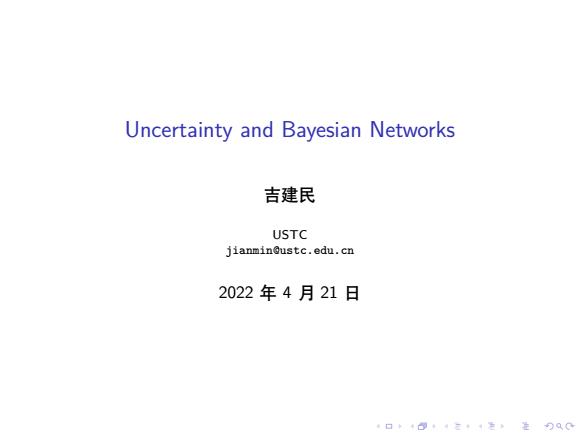
Uncertainty and Bayesian Networks 吉建民 USTC jianminOustc.edu.cn 2022年4月21日 4口◆4⊙t1三1=,¥9QC
. . . . . . . . . . . . . . . . . . . . . . . . . . . . . . . . . . . . . . . . Uncertainty and Bayesian Networks 吉建民 USTC jianmin@ustc.edu.cn 2022 年 4 月 21 日
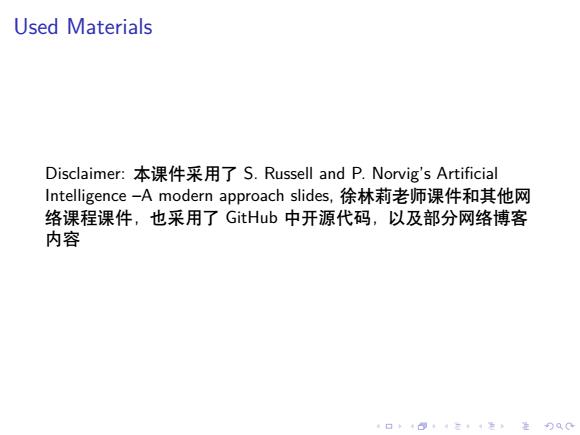
Used Materials Disclaimer:本课件采用了S.Russell and P.Norvig's Artificial Intelligence-A modern approach slides,徐林莉老师课件和其他网 络课程课件,也采用了GitHub中开源代码,以及部分网络博客 内容 口卡4三4色进分QC
. . . . . . . . . . . . . . . . . . . . . . . . . . . . . . . . . . . . . . . . Used Materials Disclaimer: 本课件采用了 S. Russell and P. Norvig’s Artificial Intelligence –A modern approach slides, 徐林莉老师课件和其他网 络课程课件,也采用了 GitHub 中开源代码,以及部分网络博客 内容

课程大纲 第一部分:人工智能概述/Introduction and Agents (chapters 1,2) 第二部分:问题求解/Search(chapters3,4,5,6) ~第三部分:知识与推理/Logic(chapters7,8,9,10,11,12) 第四部分:不确定知识与推理/Uncertainty(chapters 13, 14,15,16,17) 第五部分:学习/Learning(chapters18,19,20,21) 第六部分:应用/Application(chapters22,23,24,25) 4口◆4⊙t1三1=,¥9QC
. . . . . . . . . . . . . . . . . . . . . . . . . . . . . . . . . . . . . . . . 课程大纲 ▶ 第一部分:人工智能概述 / Introduction and Agents (chapters 1, 2) ▶ 第二部分:问题求解 / Search (chapters 3, 4, 5, 6) ▶ 第三部分:知识与推理 / Logic (chapters 7, 8, 9, 10, 11, 12) ▶ 第四部分:不确定知识与推理 / Uncertainty (chapters 13, 14, 15, 16, 17) ▶ 第五部分:学习 / Learning (chapters 18, 19, 20, 21) ▶ 第六部分:应用 / Application (chapters 22, 23, 24, 25)
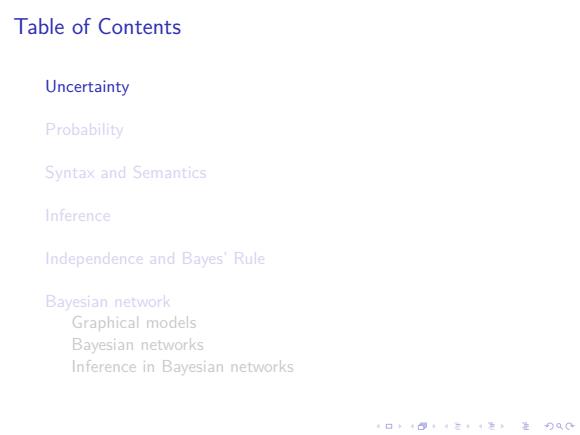
Table of Contents Uncertainty Probability Syntax and Semantics Inference Independence and Baves'Rule Bayesian network Graphical models Bayesian networks Inference in Bayesian networks 口卡回t·三4色,是分Q0
. . . . . . . . . . . . . . . . . . . . . . . . . . . . . . . . . . . . . . . . Table of Contents Uncertainty Probability Syntax and Semantics Inference Independence and Bayes’ Rule Bayesian network Graphical models Bayesian networks Inference in Bayesian networks

Uncertainty Let action At="leave for airport t minutes before flight" Will At get me there on time? Problems: ~partial observability(部分可观察性,e.g,road state,other drivers'plans,etc.) noisy sensors (e.g.,traffic reports) uncertainty in action outcomes(e.g.,flat tire,etc.) immense complexity of modeling and predicting traffic 4口◆4⊙t1三1=,¥9QC
. . . . . . . . . . . . . . . . . . . . . . . . . . . . . . . . . . . . . . . . Uncertainty Let action At = “leave for airport t minutes before flight” Will At get me there on time? Problems: ▶ partial observability(部分可观察性,e.g., road state, other drivers’ plans, etc.) ▶ noisy sensors (e.g., traffic reports) ▶ uncertainty in action outcomes (e.g., flat tire, etc.) ▶ immense complexity of modeling and predicting traffic

Uncertainty Hence a purely logical approach either: ~risk falsehood(错误风险):“A2 5 will get me there on time", or leads to conclusions that are too weak for decision making: "A25 will get me there on time if there's no accident on the bridge and it doesn't rain and my tires remain intact etc etc." (A1440 might reasonably be said to get me there on time but I'd have to stay overnight in the airport) 口卡回t·三4色,是分Q0
. . . . . . . . . . . . . . . . . . . . . . . . . . . . . . . . . . . . . . . . Uncertainty Hence a purely logical approach either: ▶ risk falsehood (错误风险):“A25 will get me there on time”, or ▶ leads to conclusions that are too weak for decision making: “A25 will get me there on time if there’s no accident on the bridge and it doesn’t rain and my tires remain intact etc etc.” (A1440 might reasonably be said to get me there on time but I’d have to stay overnight in the airport …)
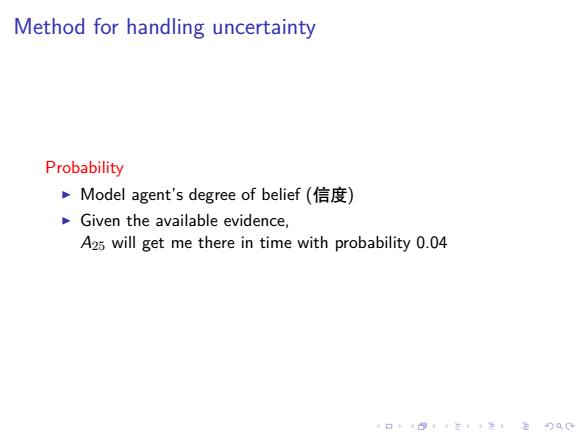
Method for handling uncertainty Probability Model agent's degree of belief(信度) Given the available evidence, A25 will get me there in time with probability 0.04 4口◆4⊙t4三1=,¥9QC
. . . . . . . . . . . . . . . . . . . . . . . . . . . . . . . . . . . . . . . . Method for handling uncertainty Probability ▶ Model agent’s degree of belief (信度) ▶ Given the available evidence, A25 will get me there in time with probability 0.04
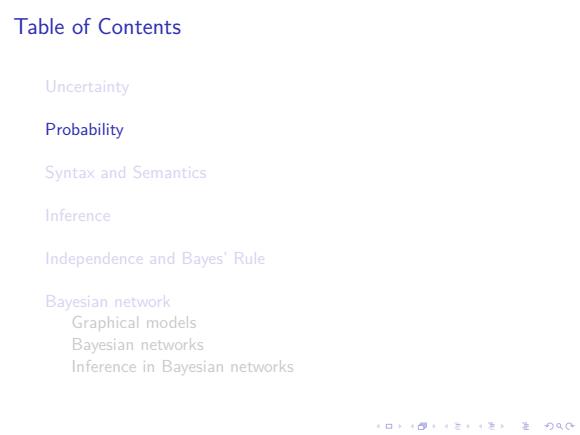
Table of Contents Uncertainty Probability Syntax and Semantics Inference Independence and Baves'Rule Bayesian network Graphical models Bayesian networks Inference in Bayesian networks 口卡回t·三4色,是分Q0
. . . . . . . . . . . . . . . . . . . . . . . . . . . . . . . . . . . . . . . . Table of Contents Uncertainty Probability Syntax and Semantics Inference Independence and Bayes’ Rule Bayesian network Graphical models Bayesian networks Inference in Bayesian networks
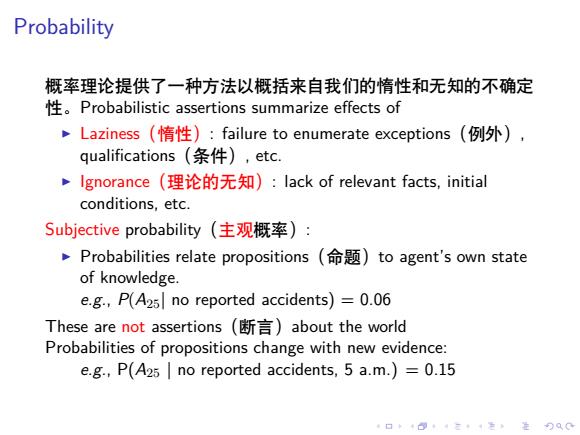
Probability 概率理论提供了一种方法以概括来自我们的惰性和无知的不确定 .Probabilistic assertions summarize effects of ,Laziness(惰性):failure to enumerate exceptions((例外), qualifications(条件),etc. ,Ignorance(理论的无知):lack of relevant facts,initial conditions,etc Subjective probability(主观概率): Probabilities relate propositions (to agent's own state of knowledge. e.g.,P(A25|no reported accidents)=0.06 These are not assertions(断言)about the world Probabilities of propositions change with new evidence: e.g.,P(A25|no reported accidents,5 a.m.)=0.15
. . . . . . . . . . . . . . . . . . . . . . . . . . . . . . . . . . . . . . . . Probability 概率理论提供了一种方法以概括来自我们的惰性和无知的不确定 性。Probabilistic assertions summarize effects of ▶ Laziness(惰性): failure to enumerate exceptions(例外), qualifications(条件), etc. ▶ Ignorance(理论的无知): lack of relevant facts, initial conditions, etc. Subjective probability(主观概率): ▶ Probabilities relate propositions(命题)to agent’s own state of knowledge. e.g., P(A25| no reported accidents) = 0.06 These are not assertions(断言)about the world Probabilities of propositions change with new evidence: e.g., P(A25 | no reported accidents, 5 a.m.) = 0.15
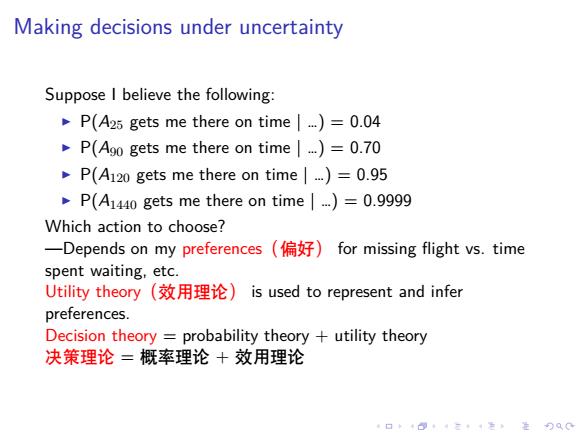
Making decisions under uncertainty Suppose I believe the following: P(A25 gets me there on time)=0.04 P(Ago gets me there on time)=0.70 P(A120 gets me there on time)=0.95 P(A1440 gets me there on time)=0.9999 Which action to choose? 一Depends on my preferences(偏好)for missing flight vs.time spent waiting,etc. Utility theory(效用理论)is used to represent and infer preferences. Decision theory probability theory+utility theory 决策理论=概率理论十效用理论 口卡回t·三4色,是分Q0
. . . . . . . . . . . . . . . . . . . . . . . . . . . . . . . . . . . . . . . . Making decisions under uncertainty Suppose I believe the following: ▶ P(A25 gets me there on time | …) = 0.04 ▶ P(A90 gets me there on time | …) = 0.70 ▶ P(A120 gets me there on time | …) = 0.95 ▶ P(A1440 gets me there on time | …) = 0.9999 Which action to choose? —Depends on my preferences(偏好) for missing flight vs. time spent waiting, etc. Utility theory(效用理论) is used to represent and infer preferences. Decision theory = probability theory + utility theory 决策理论 = 概率理论 + 效用理论